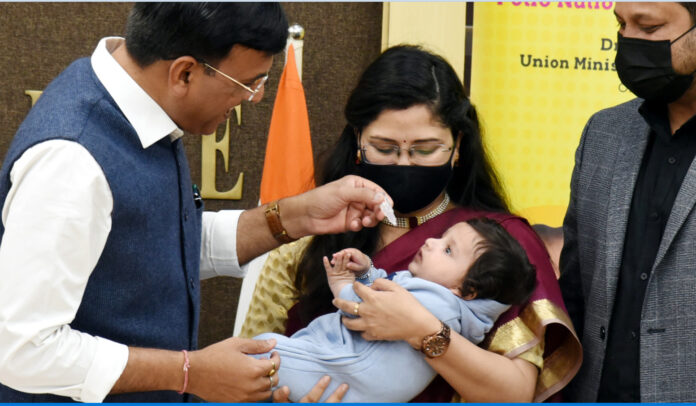Having sailed through Covid19 pandemic crisis as world’s most populous country with lowest mortality rate, India finds itself in confident position to lead the world in working towards health for all as one of the Sustainable Development Goals(SDG). This was amply evident from two recent meetings of World Health Organisation (WHO) presided by India.
World Health Assembly (WHA) of WHO which is a replica of UN General Assembly of United Nations (UN), is the highest policy decision making authority of WHO. It comprises health ministers from all countries as their representatives.
Union Health Secretary Apurva Chandra addressed the Committee A of the WHA in Geneva this week. The WHA has three main committees, which are Plenary, Committee A, and Committee B. Committee A will be chaired by India and facilitate discussion on various programmatic topics covering Universal Health Coverage, Public Health Emergency preparedness and response, antimicrobial resistance, climate change, and sustainable financing of WHO.
Chandra started his address by highlighting the alignment of the World Health Assembly’s theme this year – “All for Health, Health for All.” He focused on the core values and the ethos of India enshrined in “Vasudhaiva Kutumbakam” which means “the world is one family.” He said that during the Covid19 pandemic, India not only managed the crises within the country but also supplied medicines and health related products across the world embodying the spirit of “One World, One family.”
“This philosophy guides our efforts to promote well-being for all, facilitate Universal Healthcare Coverage and achieve health-related Sustainable Development Goals,” he stated.
The Health Secretary further stated that the traditional public health approach of focusing on community interventions such as information and awareness as well as preventive measures hold the key to better health outcomes. He informed that India has established Health and Wellness Centres to not only address health issues at the community level but to also focus on educating communities towards better health seeking behaviour.
“At this critical juncture, when all countries are working towards our collective Sustainable Development Goals and ensuring health services for all so that no one gets left behind, India has been taking the lead in advocating for digital health innovations as key to the critical transformative process required to help us achieve our goals,” he further stated.
It is heartening to know that India already very close to achieving SDG target of minimising Maternal Mortality Ratio (MMR) to 70 per lakh live births by 2030. The fatal ratio in India has declined by 10 points. Remarkable decline of more than 15% in MMR has been reported by states of Kerala, Maharashtra and Uttar Pradesh. The states that have achieved SDG target have increased from five to seven as on today.
The latest available data reveals that MMR of India has declined by 10 points as per the Special Bulletin released by the Registrar General of India, which is a very significant achievement.
The ratio has seen 8.8 % decline from 113 in 2016-18 to 103 in 2017-19. The country has been witnessing a progressive reduction in MMR from 130 in 2014-2016 down to 103 in 2017-19. With this persistent decline, India is on the verge of achieving National Health Policy target of 100 per lakh live births by 2020 and certainly on track to achieve the SDG target of 70 per lakh live births by 2030.
The number of states which have achieved the Sustainable Development Goal (SDG) target are: Kerala (30), Maharashtra (38), Telangana (56), Tamil Nadu (58), Andhra Pradesh (58), Jharkhand (61), and Gujarat (70). There are now nine (9) States that have achieved the target of MMR set by the National Health Policy which include the above seven states, and Karnataka (83) and Haryana (96).
However, five states [Uttarakhand (101), West Bengal (109), Punjab (114), Bihar (130), Odisha (136) and Rajasthan (141)] have MMR in between 100-150, while for four states namely, Chhattisgarh (160), Madhya Pradesh (163), Uttar Pradesh (167) and Assam (205) have MMR above 150. Four states namely West Bengal, Haryana, Uttarakhand and Chhattisgarh have shown an increase in MMR and hence will need to reappraise their strategy and intensify their efforts to accelerate the MMR decline to achieve the SDG target.
But at the same time, encouraging achievement has been reported by Uttar Pradesh which has shown the maximum decline of 30 points, followed by Rajasthan (23 points), Bihar (19 points), Punjab (15 points) and Odisha (14 points).
Which means even among the states ranking low on scale, speed of closing the SDG gaps on health front are closing fast. This is no small feat in a country as colossal and people as diverse as this. It is patently unfair and illiterate to compare India’s health systems to countries like Singapore which is smaller than even several cities in India.
It ain’t for nothing India, which once ranked low on health indices and was identified with its BIMARU states (Bihar, Madhya Pradesh, Rajasthan, and Uttar Pradesh), finds itself today on the centrestage of WHO.



